|
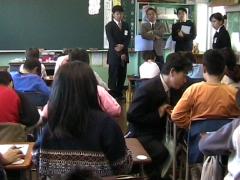
Observers line the classroom
|

|
Kounai-ken in action (0.25 minutes)
The boy (to the right) counts observers
|
What is the focus of your investigation? In
my contribution to our symposium I will be examining the role of kounai
ken in Japanese Teachers' Professional Development based on the paper
given by Asada (2004). From here, I will reflect on my observations of
two sessions of kounai ken during a visit to Niigata and Tokyo in
December 2004. I will compare and contrast experiences in OFSTED
inspection with my understandings of this primary form of teachers'
professional development in Japan. Finally, I will seek to show how my
learning has been informed by my experience of kounai-ken. I have been
invited to offer lecture workshops about mentoring integrated with
action research during five visits to a total of three locations in
Japan since 2000. In
my presentation, I will look at how my approach to integrating
mentoring in action research to assist teachers' professional
development has evolved as a result of my visits and research
collaboration with Professors Asada and Ikuta. Using the PowerPoint
presentation that I prepared for my most recent visit to speak to
teachers as potential action researchers in Tokyo, I will share my own
perception that mentoring relationships might be integrated into
kounai-ken in order to sustain this form of Continuing Professional
Development for teachers. Mentoring in Japan is usually associated with
a hierarchical apprenticeship model but I suggest that a model of
mentoring as collaborative enquiry could become a more useful
perspective, not only for initial teacher training but also for career
long development. In
my paper I will explicate how my approach to action research has been
modified in the light of sharing understandings I have gained.
Increasingly, I am coming to realise that, starting from a positive
basis "I am good at ... but want to improve can be a better for
professional development than "I have a problem."
|
|
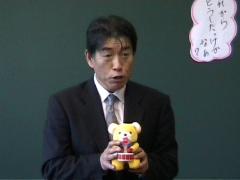
The stimulus for this class' story writing
|

|
The assistant principal arrives!
|
What resources have you found helpful? Asada, T. (2004) A Case Study on the Function of Kounai-ken for Teachers' Professional Development in Japan, BERA 2004, Manchester Fletcher, S. (2000) Mentoring in Schools: A Handbook of Good Practice, London, RoutledgeFalmer Ikuta, T. and Takahashi, T. (2004) A Study of Japanese Teachers' Practical Knowledge by means of an on-going cognition method, paper presented at BERA 2004, Manchester Lewis, C. (2000) Lesson Study: The Core of Japanese Professional Development, invited address to the SIG on Research in Mathematics Education, AERA, New Orleans, April 28, 2000 McNiff, J. (2002) Action Research Principles and Practice, London, RoutledgeFalmer MEXT, (Ministry of Education, Culture, Sports, Science and Technology, (2002) Developing a Strategic Plan to cultivate "Japanese with English Abilities" accessed at http://www.mext.go.jp/english/news/2002/07/020901.htm on 16 August 2004 MEXT (1998/7) National
Curriculum Standards Reform for Kindergarten, Elementary School, Lower
and Upper Secondary School and schools for the visually disabled, the
hearing impared amd the otherwise disabled.
Research about CPD in Japan
This link takes you to the section devoted to Japanese educators' writings in the web site at http://www.TeacherResearch.net
|
|

|
Toni shares her insights into her successful practice with the teacher research group at Westwood St Thomas School. (1.25 minutes)
|
|
|
|
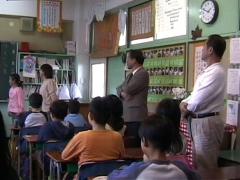
Close observations as the lesson unfolds
|

|
Children listen to teachers' instructions (0.25 minutes)
|
What results have emerged? Kounai ken (Asada, 1994) is the main form of teachers' CPD (continuing professional development) in Japan. It
is divided into three parts: Jitzen-ken (before the lesson) which is
discussion about the lesson planning; Teaching in the classroom;
Jigo-ken (after the lesson) where there is discussion about the
observed lesson by all teachers and (potentially) the creating of new
practical knowledge. The
first two sections are paralleled in my experience of OfSTED
inspections n the UK, but the third - where all the observers have an
opportunity to discuss what happened in class and pass judgement, is
different. Some of the observers are from the same school as the
teacher being observed, some from faculty and some from the
city/prefecture board of education. Usually just one OfSTED inspector
is present a lesson. In Japan the observers line the classroom and
freely circulate to ask the students about their learning. It is a much
more communal event and occurs 6 times in each school year, on average. According
to Asada (1994) 'In Japan almost all schools have many, many problems
which are bullying, refusal to go to school, declining achievement and
so on'. The aim of this study is to ascertain the potential benefit of
integrating action research with mentoring into the practice of
Kounai-ken, to enhance teachers' professional development and to help
them enhance teaching and learning in Japanese schools. 'Kounai-ken
is regarded as the key place of learning in community for teachers ...
in spite of the importance of peer tachers for teacher development,
little is known about the kind of practical knowledge which teachers
have individually and would be actually expressed, created, and
regenerated by teachers in kounai-ken.' (ibid, 1994)
|
|
|
The changing culture of CPD in Japanese schools According
to Lewis (2000) 'Within Japanese schools, and perhaps within Japanese
culture more widely, hansei - self-critical reflection - is emphasised
and esteemed. Both teachers and students set goals for self-improvement
in a quest for character improvement (that) is close to being a
national religion.' So why is there a growing problem in truancy,
bullying and underachievement in Japanese schools? partly this is to do
with the influx of ideas and role models from outside Japan - many
inducted through the Internet which gives easy access to youth cultures
of variable productive value. Partly, it is due to a shift in focus in
Japan where there has been a steep incline in the attention given to
becoming more western (MEXT, 2002). Partly it is because, as in the UK,
the speed and frequency of government initiatives have often overtaken
teachers' capacities to evolve educational practice and some teachers
are feeling disillusioned and exhausted.Nevertheless, Kounai ken
(Asada, 1994) is potentially a highly effective form of professional
development as it is rooted in consultation in lesson planning,
observation and post-observation discussion. Additionally it regular
and regulated by outside agencies (the Prefecture) as well as by the
school inspected(Lewis, 2000) The
National Curriculum (1998) stresses the centrality of a highly skilled
and autonomous workforce ' 5. Teachers: It is necessary to place great
value on children' ability to learn and think independently, to select
educational content carefully and to make efforts to improve
educational activities. To promote these successfully, teachers need to
improve their teaching skills. This requires further improvement on
teacher training, appointment and in-service training'.
|
|
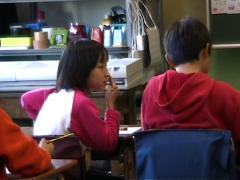
Almost everyone seemed sure what to do.
|

|
Individual effort is rewarded in class.
|
|
|

|
How can we learn about this lesson? (1.00 minutes)
|
|
|
|
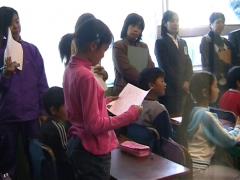
Video and non-participant observation in class
|

|
Children read aloud the account they have written (0.5 minutes)
|
What was your approach and/or what evidence have you gathered? This
web-based snapshot represents the climax of five years collaborative
enquiry with Professors Asada and Ikuta and colleagues who share my
commitment to mentoring and action research. We have engaged in enquiry
together, exploring ways of enabling teachers' continuing professional
development in our respective countries. We have drawn on the idea of
Mc Niff and Whitehead (2002) but over time and through experience we
have extended the work of these authors. In 2000 I visited japan with
Jack Whitehead and I well remember co-presenting workshops with him.
His approach to action research focusing on the "i" is enabling where
more traditional positivist approaches can inhibit the expression and
explication of teachers' experiences of their own professional growth.
However, since that visit I have come to realise that in a culture were
'face' is important starting from the premise "I have a problem" can be
inhibiting for some teachers. Similarly
much of the jargon and quasi-philosophical debate has unfortunately
ring-fenced aspects of self-study action research (witness the JISCmail
discussion group for the Practitioner Research SIG whose outcome was to
establish a new and more simply spoken TeacherResearch discussion
group). The approaches that my Japanese colleagues and I have adopted
has been and continues to be rooted in practical considerations. We
work together trying to find ways to improve teachers development and
implementing action research ad mentoring in the process. However,
whereas action research of the kind How can I improve? is developing a
strong following mentoring in Japan remains at present restricted
largely to instruction reified in a highly hierarchical model (Asada,
2005, presentation to BERA in this symposium).Colleagues in Japan are
using video, audio recording and emails to explore mentoring and
provide data which we can synthesize into evidence to support our
claims to know. We are collaborating to change the culture to an
understanding of mentoring as action enquiry to improve practice and in
the process we are aiming to enable teachers to co-create new knowledge
as they improve their teaching and students' learning.
|
|
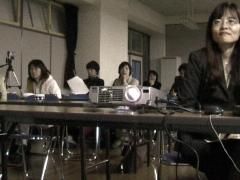
Observations on this Kounai ken are shared
|

|
Professor Asada discusses Kounai-ken (0.20 minutes)
|
Interim Conclusions I
have called this interim conclusions because although the successful
introduction of action research is well underway in some areas (the
work of Professors Asada, Ikuta and Sawamoto respectively in Kobe and
Tokyo, in Niigata and again in Tokyo is highly significant) mentoring
as instruction based on the traditional model of apprenticeship in
Japan continues to hold sway in teacher education. During my last visit
in December 2004, I sensed an excitement and great interest in the
potential of enabling a flat hierarchy in mentoring where there is
potential for an exchange of expertise. There are inhibiting factors -
not least in initial teacher training the practicum of just four weeks
in schools. However, action research with mentoring as CPPD (continuing
personal and professional development (Fletcher, 2000) seems to offer
substantial promise. My
own experience of participating twice in Kounai ken (in Tokyo and in
Niigata) leads me to the tentative conclusion that Kounai-ken is
followed by less of an open discussion than a pronouncement of how the
lesson has been perceived by observers coming to a (not necessarily)
concensus view. The role of the sensei or master teacher tends to be
venerated, Teachers may not always concur with the observers' opinions
but they seem somewhat reticent to challenge them and share insights.
It seems to me that Kounai ken offers a unique and practice enhancing
experience. However the culture of waiting for a party of experts to
pronounce on the merits and weaknesses of a lesson rather than engaging
in democratic debate may be an opportunity as yet not fully exploited
for the growth of new knowledge about pedagogy. Asada (2004) confirms
this perspective where he says that as yet we know little about
teachers' own practical knowledge. It tends to remain tacit. One
wonders if discussion between teachers and on-going action research
integrated with mentoring as co-enquiry as a whole school approach to
improving practice might not be a workable and useful development.
Certainly this wold be my perspective as a valuable development in the
UK in preparartion for OfSTED inspections. Rigorous classroom based
research with peer mentoring could generate knowledge. Web-based
snapshots like this, (Carnegie KEEP Toolkit) could be the ideal tool
for sharing and disseminating ideas.
Mentoring and action research in Bitterne Park School
|
|
|